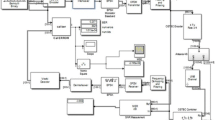Abstract
In this paper a novel jamming technique is presented. The idea of the proposed jamming technique is based on adding inphase and quadrature impairments to the jamming signal. The jammer is simply a quadrature phase shift keying signal. The bit error rate probability (BER) of the proposed jamming signal is derived analytically and validated with the aid of the software defined radio SystemVue design software. The standard multi input multi output (MIMO) wireless local area network (WLAN) IEEE802.11n communication system is chosen as the victim system. Its BER performance is simulated in the presence of the proposed jamming signal in multipath fading channel. Finally, the efficiency of the proposed jamming signal on the MIMO WLAN IEEE802.11n communication system is practically measured in the laboratory where a practical experiment is held and the efficiency of the proposed jamming signal is compared with the traditional single tone jamming signal. It will be shown practically that the proposed jamming technique outperforms the traditional single tone jamming signal by nearly 15 dBm on the impact of efficiently jam the MIMO WLAN IEEE802.11n communication system.















Similar content being viewed by others
References
Shaheen, E. M., & Eltanany, M. (2010). The impact of narrowband interference on the performance of UWB systems in the IEEE802. 15.3 a channel models. In 23rd Canadian conference on electrical and computer engineering.
Bek, M. K., Shaheen, E. M., & Elgamal, S. A. (2016). Analysis of the global position system acquisition process in the presence of interference. IET Radar, Sonar and Navigation Journal,10(5), 850–861.
Fan, Y., Liao, X., & Vasilakos, A. V. (2017). Physical layers security based on interference alignment in K-user MIMO Y wiretap channels. IEEE Access,5, 5747–5759.
Jia, S., Zhang, J., Zhao, H., & Zhang, R. (2017). Relay selection for improved security in cognitive relay networks with jamming. IEEE Wireless Communications Letters,6(5), 662–665.
Wang, H., Yao, Y., Wang, R., & Shen, L. (2015). Coordinated jamming and communications in a MC-CDMA system. IEEE Transactions on Aerospace and Electronic Systems,51, 3151–3160.
Kristem, V., Molisch, A. F., & Christen, L. (2018). Jammer sensing and performance analysis of MC-CDMA ultrawideband systems in the presence of a wideband jammers. IEEE Transactions on Wireless Communications,17, 3807–3821.
Gao, J., Vorobyov, S. A., Jiang, H., & Poor, V. (2015). Worst case jamming on MIMO gaussian channels. IEEE Transactions on Signal Processing,63(21), 5821–5836.
Mukherjee, A., & Swindlehurst, A. L. (2013). Jamming games in the MIMO wiretap channel with an active eavesdropper. IEEE Transactions on Signal Processing,61(1), 82–91.
Wang, H., Wang, R., & Shen, L. (2015). Coordinated jamming and communications in an MC-CDMA system. IEEE Transactions on Aerospace and Electronic Systems,51(4), 3151–3160.
Poisel, R. A. (2011). Modern communications jamming principles and techniques (2nd ed.). Washington: Artec House.
Bayram, S., et al. (2012). Optimum power allocation for average power constrained jammers in the presence of no gaussian noise. IEEE Communication Letter,16(8), 1153–1156.
Amuru, S., & Buehrer, R. M. (2015). Optimal jamming against digital modulation. IEEE Transactions on Information Forensic and Security,10(10), 2212–2224.
Proakis, J. G., & Salehi, M. (2008). Digital communications (5th ed.). NewYork, NY: McGraw-Hill.
Author information
Authors and Affiliations
Corresponding author
Additional information
Publisher's Note
Springer Nature remains neutral with regard to jurisdictional claims in published maps and institutional affiliations.
Rights and permissions
About this article
Cite this article
Shaheen, E.M. Performance of MIMO IEEE802.11n WLAN in Presence of QPSK Jammer with Inphase/Quadrature Origin Offsets. Wireless Pers Commun 113, 555–574 (2020). https://doi.org/10.1007/s11277-020-07232-2
Published:
Issue Date:
DOI: https://doi.org/10.1007/s11277-020-07232-2




